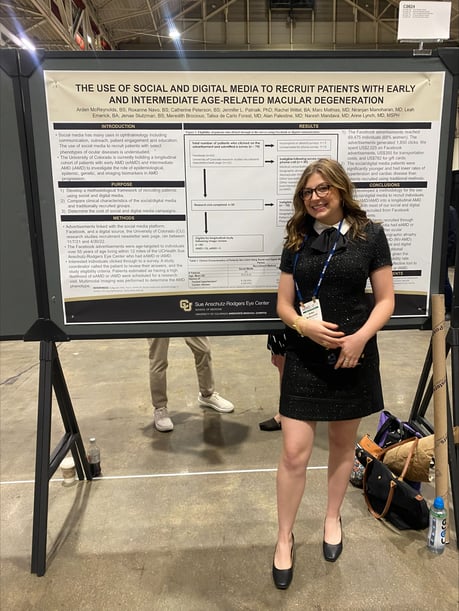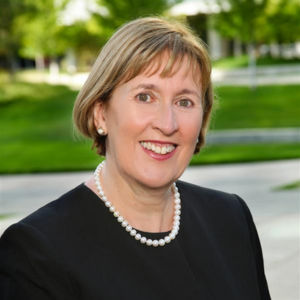When Anne Lynch, MD, MSPH, professor and director of the Division of Ophthalmic Epidemiology in the University of Colorado Department of Ophthalmology, wanted to recruit more patients with early and intermediate age-related macular degeneration for research, she and a team of researchers turned to social media to engage the community.
“Social media has been used for teaching, for outreach, and in private practice to connect with patients, but not so much for active recruitment into ophthalmology studies, which is what we really wanted to do,” Lynch explains.
The goal was to develop a methodology so that if the endeavor was successful, it could be replicated by other researchers.
“We were really pleased with the results,” Lynch says. A series of social media posts recruiting AMD patients reached nearly 70,000 individuals and generated 1,850 clicks over the course of six months. The results of the study were published in Clinical and Experimental Ophthalmology and presented at the recent meeting of the Association for Research in Vision and Ophthalmology (ARVO).

Arden McReynolds presents a poster on the use of social and digital media to recruit AMD patients at the 2023 meeting of the Association for Research in Vision and Ophthalmology (ARVO). Photo courtesy of Arden McReynolds.
In the end, 74 patients were deemed eligible for a research visit after they completed an online survey and follow-up phone interview. Researchers confirmed that 20 of those recruited patients who visited the Sue Anschutz-Rodgers Eye Center presented with early AMD or intermediate AMD and could be included in the study.
AMD is an eye disease that results in vision loss in the center of the eye and typically occurs in patients 50 and older. Symptoms in early stages of the disease can be minor or non-existent, but as AMD progresses, so does vision loss.
Traditional recruitment vs. social media outreach
Normally, recruitment takes places in the retina clinic with patients who are already regularly visiting a Sue Anschutz-Rodgers Eye Center vitreo-retinal specialist.
“We can look at the schedule beforehand and see if a patient qualifies for research,” says Arden McReynolds, BS, senior research coordinator for the Division of Ophthalmic Epidemiology. “It can be great because we utilize the standard of care imaging that they get every six months along with a blood draw, which we use to measure biomarkers for AMD.”
The patients recruited through social media had a heightened curiosity about the research and their desire to be involved. They were also younger and had fewer co-morbidities than the patient recruited at the retina clinic.
“They are very motivated and want to know about everything we are doing,” Lynch says. “Everybody in the ophthalmology community is anxious to find something to prevent the progression of this really horrible disease.”
The online recruitment effort took a significant amount of work upfront, including approving the campaign, the language, and images with the Colorado Multiple Institutional Review Board, which ensures the integrity of university research.
Advertisements on Facebook were created to target an audience of people 55 years and older, who lived within an appropriate driving distance from the CU Anschutz Medical Campus, and included language and photographs that might interest people who fit the profile the researchers were looking for.
“It was important that our study appeal to patients who are most often impacted by AMD, while ensuring those who engaged with the ad felt assured that their participation would be conducted in an ethical and transparent way,” says Rachel Wittel, communications program manager for the Department of Ophthalmology, who organized the ads.
Leveraging longitudinal research
The researchers recruited the patients because they are building a longitudinal cohort of patients with early and intermediate AMD to investigate the role of systemic biomarkers in the disease’s progression.
“The overall objective of the biomarker study is to identify a profile of individuals early in the natural history of the course of AMD who are at risk of progression to the more advanced forms of this visually disabling disease,” Lynch explains. “This study will present an opportunity to develop targeted interventions to interrupt the natural history of AMD by preventing progression from intermediate AMD to advanced AMD.”
Lynch says in terms of research, this study is one of low risk and tailored to the patients. Researchers organized Lyft rides for patients recruited through social media so that it was easy for them to arrive at the clinic, have their eyes dilated, and give a blood sample.
The patients who were found to have early or intermediate forms of AMD were also entered into the center’s patient research registry, which is among the largest AMD registries in the country. Right now, there are 1,800 patients in the center’s AMD registry, and 435 of those patients have the intermediate stages of the disease.
Because the first six months were so successful, Lynch and McReynolds have gone on to recruit patients with all forms of dry AMD (early, intermediate, and advanced dry forms of AMD).
“We were very happy with our results and decided to keep going,” Lynch says. “We’ve enrolled an additional 28 patients since November.”


.png)

.png)